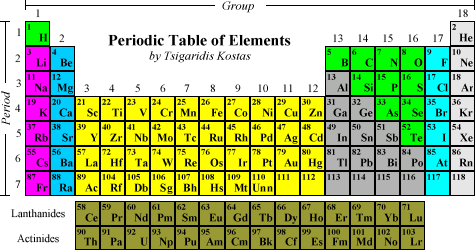
The Periodic table is designed to help you predict what an element's physical and chemical properties are. You can also predict what elements will bond with each other.
First, let's look at the columns and rows of the periodic table.

Groups or Families
The vertical columns of the periodic table (there are 18) are called groups or families. Elements in the same group or family have similar but not identical characteristics. You will learn more about the 18 groups in a later section. You can know properties of a certain element by knowing which group it belongs to.
Periods
The horizontal rows of the periodic table are called periods. Elements in a period are not alike in properties. As a rule, the first element in a period is usually an active solid, and the last element in a period is always an inactive gas. Atomic size decreases from left to right across a period, but atomic mass increases from left to right across a period. Atoms on the left of the period, therefore, are usually larger and more lightweight than the smaller, heavier atoms on the right of the period.
Think Inside the Box
When you look at the periodic table, you should notice that each box represents a different element, and each box contains vital information about the element, including its name, symbol, atomic number, and atomic mass. Look at the sample box below for a description of each of these pieces of information.
6CCarbon12.011 |
The top number is the atomic number . Every element has its own unique atomic number. The atomic number tells how many protons are in one atom of that element. Since no two elements have the same atomic number, no two elements have the same number of protons.
The large letter is the element's symbol, and just below that is the element's name. Each element has its own unique symbol and name. It is often very useful to memorize symbols and names for elements, especially the more commonly used elements.
Below the name is the element's atomic mass . The atomic mass is the mass in atomic mass units for all possible isotopes of that element. The atomic mass essentially gives you an estimate of how massive one atom of that element is.
Recognizing that it is often important to memorize elements' names and symbols, following are five links that will take you some fun websites for some memory games relating to symbols and names.